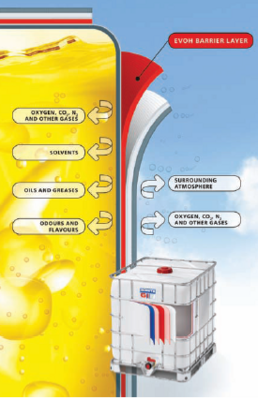It is already two years since the German Federal Institute for Materials Research and Testing (BAM) warned of the very real dangers revealed by a research project, which demonstrated that an explosive atmosphere can arise relatively quickly as a result of solvent permeation even when plastic containers (IBCs) are transported under normal conditions in ventilated containers. This even applies when there is full compliance with ADR/RID limit values. In this connection, BAM recommends the future use IBCs and other transport containers equipped with a permeation barrier. After all, tests carried out in real and simulated conditions showed that barriers such as SMP and EVOH (effective gas and permeation barrier) or polyamide significantly reduce the potential risk. Permeation was not sufficient for the explosion threshold to be reached inside the freight containers. The findings of the BAM study prompted a reaction from the UN Sub-Committee of Experts on the Transport of Dangerous Goods in Geneva. As the de facto international legislative body, it has included a clear recommendation for 2011 in the 16th revised edition of the UN Orange Books to the effect that volatile, flammable hazardous substances should in future only be transported in plastic containers that prevent permeation under normal transport conditions and therefore hinder the formation of explosive compounds. This is precisely where the idea for developing EVOH IBCs came from. The aim was to offer the market a transport container that would tolerate no compromises where safety was concerned, while at the same time matching the properties of stainless steel containers and also uniting all the benefits of a composite IBC. A key aspect here is the far lower cost. A comparison along the entire supply chain reveals that the cost of transporting hazardous goods in these EVOH IBCs is 25 per cent lower than in other forms of packaging. The new development was based on Security Layer Technology, an extrusion blow-moulding process specially designed to plasticise up to six different functional materials simultaneously. Thanks to this technology, the EVOH barrier, a copolymer of ethylene and vinyl alcohol, can be embedded in IBC walls. The barrier effect of EVOH effectively prevents permeation through the container wall of toluenes, xylenes, MEK and benzene, as well as oils, greases, aromatic substances, flavourings and ambient gases (oxygen, nitrogen), and also any media requiring a nitrogen injection, so explosive or harmful compounds on the outside shell of the IBC are ruled out from the outset. With an optionally conductive (black) or antistatic (white) outer layer, the IBCs are suitable for use in ex zones 1 and 2. The approach to solving the problem by means of ventilation and cooling solely was hardly convincing. Air exchange rates measured under different conditions painted a clear picture. Even in a freight container with 32 vents carrying 16 toluene IBCs, it was not possible to prevent the formation of explosive compounds. Another drawback is the dependence of permeation behaviour on ambient temperature. The formula here is: the warmer it is - the greater the permeation. During a climate-measuring trip on board a ship bound for Singapore, temperatures of up to as high as 48ºC were recorded. The filling goods themselves reached temperatures of up to 36ºC. All in all, Schütz and BAM share the conviction that barrier IBCs in ventilated containers are the best way to eliminate the danger of explosive gas compounds arising. After all, the EVOH barrier always works – no matter how hot or cold it is, whether the freight container is full or almost empty.
Amended Legislation on Hazardous Goods Transports
Greater safety in the transport of hazardous goods is the subject of intensive debate. This applies in particular to the formation of explosive compounds in freight containers as a result of permeation through the walls of plastic containers.
- by Schütz GmbH & Co KGaA
- March 23, 2010
- 764 views


















